Gloria Truly Estrelita, Jim Donaghey, Sarah Andrieu, Gabriel Facal
A Brief History of Anarchism in Indonesia
Anarchism in the context of anti-colonialism and nationalism in Indonesia
The repression of the Left, and anarchism’s re-emergence
Anarchism under repression, and the significance of contemporary anarchist critiques
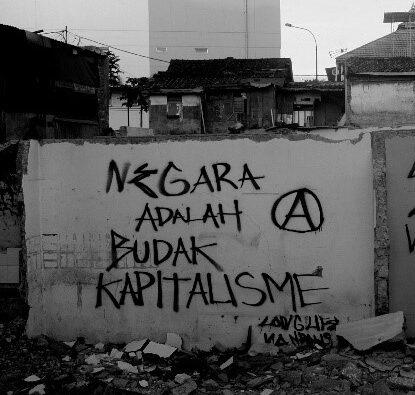
In the Indonesian language, the term ‘anarki’ is synonymous with the riotous behaviour of a disparate range of groups, including everything from Islamic fundamentalists to football fans. The state has played a role in shaping this popular discourse of anarchy-as-chaos, including in their establishment of an ‘anti-anarchy’ police division in 2011, which actually targeted rioting by religious mobs (this police division was itself an implementation of the Indonesian state’s Procedural definition of ‘anarki’, see their ‘Prosedur Tetap (Protap) Anti Anarki’ of October 2010 (Lastania et.al 2010)). In more recent years, the state has shifted its discourse to identify anarchism as a form of populist terrorism, with purported links to communism – which remains highly taboo in Indonesia and, in its Marxist-Leninist guise, is still officially proscribed by the state (Guritno 2022). The authorities use the term ‘anarko-sindikalis’ to differentiate this form of anarchism from the ‘anarki’ of other rioters, and groups identified as such suffer persecution. This contemporary scenario, and the longstanding ‘red scare’ in Indonesia, means that speaking out on the anarchist movement remains delicate.
Anarchism in the context of anti-colonialism and nationalism in Indonesia
Far from the stereotypes that are conveyed, the anarchist movement in Indonesia is made up of diverse groups with various ideas and practices. Analysts of political life in Indonesia observe that pragmatic issues often override ideological considerations (Rosanti 2020). Political parties and trade unions organise themselves in terms of religion, regionalism, or ethnic identity, relying on pre-established societal networks. Indeed, despite the democratisation reforms after the fall of the Suharto regime in 1998, engagement in any form of progressive politics is suspected of being Socialist-oriented, and is closely monitored by the intelligence agencies and their local civilian supporters (Honna 1999: 121).
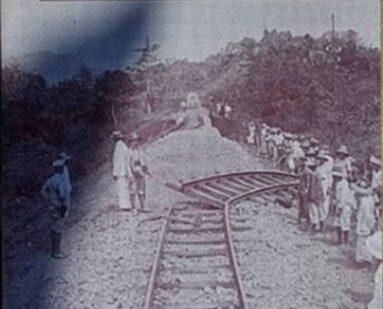
This was not always the case. During pro-independence struggles in the late nineteenth and early twentieth centuries, anarchism was influential on anti-colonial thinking, arriving in Indonesia alongside the upswell of communism and nationalism under the regime of the Dutch East Indies (Satria Putra 2018; Nugroho 2021). The first book to describe ‘anarchistic’ tendencies in the Dutch East Indies was the novel Max Havelaar, written by Eduard Douwes Dekker under the name ‘Multatuli’ in 1860. The book strongly criticised the Dutch East Indies colonial government, and the work inspired many anarchists (Satria Putra 2018). Multatuli’s struggle was then continued by his grandson, Ernest François Eugène Douwes Dekker, who linked up with radicals struggling for the liberation of the colonies while on a trip to Europe in the early 1910s.
During World War One, in 1916, the Dutch East Indies newspaper Soerabaijasch Nieuwsblad reported on a sabotage led by a young anarchist navy soldier (Blom 2004). This resonated with the prolific anti-war propaganda works of the time, which in the Dutch East Indies was chiefly disseminated by Christian-anarchists and Tolstoysans (it is notable that E.F.E. Douwes Dekker himself described Jesus Christ as a fighter for freedom and ‘a great anarchist’ (Van Dijk 2007)).
The anarchist movement in the Dutch East Indies was also influenced by Chinese anarchists in the years before the First World War, and Indonesia-based activists maintained close contact with anarchists in China, the Philippines, and British Malaya. The Chinese anarchist movements established reading houses all over the Dutch East Indies from 1909 onwards, which published numerous newspapers and became a loose political association opposing the Dutch authorities.
Anarchist ideas also caught the attention of several young Indonesian students in the Netherlands, who later developed contacts with local Dutch anarchists. Among them was the first prime minister of the Republic of Indonesia, Sutan Sjahrir (Damier & Limanov 2017, Mrázek 1994). These young students established links with left-wing political forces and took part in the work of the International League Against Imperialism and Colonial Oppression, or also known as the World Anti-imperialist League (Satria Putra 2018).
With echoes of the contemporary situation in Indonesia, the colonial government used the anarchist label to arrest those who criticized the government. For example, in 1927, the Dutch authorities arrested several members of Sarekat Ra’jat (formerly known as Sarekat Islam Merah, or Red Islamic Association), who were found guilty of the charge of anarchism, and subsequently banished to West Papua (Suryomenggolo 2020).
From the 1920s onwards, the Communist Party of Indonesia (in Indonesian language, Partai Komunis Indonesia or PKI) exerted its influence at the local level, solidifying a strong popular base, especially after Indonesia’s declaration of independence in 1945. It was one of the big winners in the first general election of 1955, and by the 1960s grew to become the third-largest communist party in the world with three million members, plus a constellation of satellite grassroots organisations (Lev 2009). After becoming aware of the covert involvement of the United States and the United Kingdom in the revolts of 1957-1961 (Conboy and Morrison 2018) and their meddling provocation of the Indonesia-Malaysia confrontation of 1962-1966 (Wardaya 2008), the nationalist President Sukarno came to support the PKI’s anti-Western position. In the wider context of the Cold War, this led other political parties, right-wing army leaders, and Western governments, to fear that the communists were taking over the country.
But while Sukarno embraced some Leftist groups, he was not sympathetic to the anarchist movement (even despite his habit of quoting the anti-colonial writings of Mikhail Bakunin during his speeches (Danu 2015)). Earlier in Sukarno’s political career, in 1932, he published an article titled ‘Anarchism’ in Fikiran Ra’jat (or People’s Thought ) daily, the newspaper of the Indonesian Nationalist Party (the PNI). In it, Sukarno expressed his opposition to the anarchists and their rejection of the state and patriotism. While he could agree with the anarchists in their fight against colonialism, Sukarno was a nationalist and a statist first-and-foremost.
Anarchist thought had a wide-ranging influence. Even the avowedly Marxist-Leninist PKI featured quotes from Bakunin in the editorials of their Koran Api journal in the 1920s – though the author, Herujuwono, a Party Chairman in Central Java, was scolded by Darsono, a PKI founder, in 1926 for muddying the Party’s ideological purity. However, this episode does highlight the considerable heterogeneity of the Left in Indonesia, with significant cross-pollination of ideas across political milieus under the overarching anti-colonial struggle (Satria Putra 2018).
The repression of the Left, and anarchism’s re-emergence
The tragedy of 1965-1966 brutally curtailed the political trajectory of the PKI and other leftist groups in Indonesia. On September 30, 1965, in response to the assassination of high-ranking army officers, the military under Major General Suharto took control of the country, accusing the PKI and its affiliates of responsibility for the assassination plot. The most significant anti-communist purge in modern Indonesia was launched on an archipelago-wide scale. In 2016, the International People’s Tribunal set a consensus estimate of 500,000 people killed during the atrocities (IPT Report 65 2016).
As soon as it seized power, General Suharto’s New Order regime demonised communism in its propaganda and prohibited Leftist philosophy, politics and imagery (Estrelita 2010). In a country where religion was compulsory and directly associated with political power, the conflation of communism with atheism had a powerful effect. State institutions and the people themselves were involved in daily repression that turned Indonesia into an anti-communist surveillance society.
After thirty years of repression and marginalisation under this wide ranging ‘red scare’, anarchist activism re-emerged in the 1990s. Its revitalisation was fostered by student movements across the archipelago and particularly by punk counter-culture (Satria Putra 2018; Anjani 2020). At that time, anarchism was synonymous with punk – the punk community learned about anarchism through the lyric sheets of anarchist-engaged punk bands, and through punk-anarchist zines from the US and Europe, which were transported to Indonesia by travelling punks, and then copied and re-distributed, and translated in locally produced zines (Donaghey 2016). The discourse of anarchism diversified in the ensuing years, influencing activists, students, and workers, and eventually reaching a wider society with diverse backgrounds.
During the political upheavals against the New Order regime in the late 1990s, many anarchist sympathisers claimed membership of Anti-Fascist Front (Front Anti-Fasis, FAF), which was founded in 1997 in Bandung, bringing together punks, street kids [anak jalanan] and petty thugs [preman]. Some FAF members joined the socialist People’s Democratic Party (or PRD) in 1999 (F Putra 2022), but this was a disappointing experience for the anarchist-minded activists, and the opinion of those who had kept their distance from the PRD was vindicated – they had argued all along that entry into party politics led to co-optation and the stifling of critical speech (anonymous interviewee 2022).
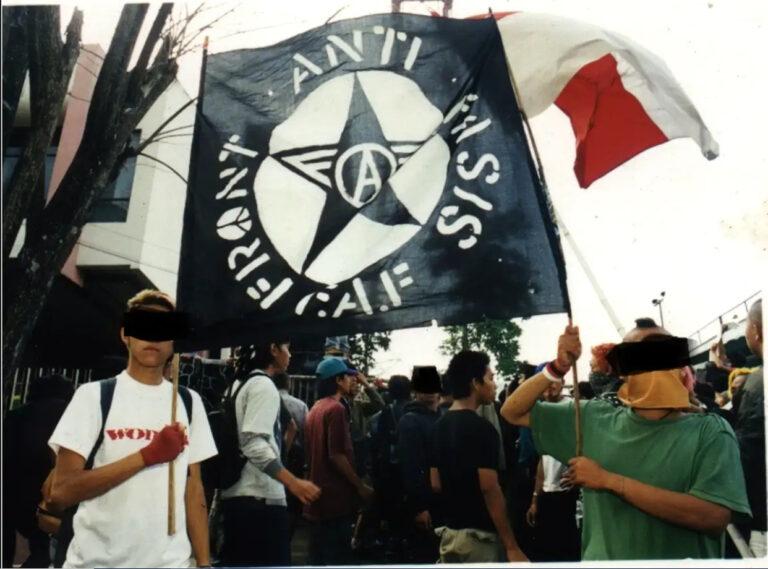
Even within this alliance, FAF supporters autonomously continued their underground activism. In December 1999 and February 2000, they met with punk groups in Yogyakarta and formed the Jaringan Anti Fasis Nusantara (JAFNUS, or Archipelago-wide anti-fascist network), which was subsequently suppressed by the Gerakan Pemuda Ka’bah (or GPK) civil militia, who accused the activists of being communists (anonymous interviewee 2022).
A later effort to consolidate anarchistic groups within a network saw the creation of the Jaringan Anti-Otoritarian (JAO, or Anti-Authoritarian Network) in 2006 (F Putra 2022). In addition to its role as a rallying point for large-scale May Day demonstrations in 2007 and 2008 (the latter of which was severely repressed by the police), and the introduction of black bloc tactics and aesthetics, the JAO federation linked together the intersecting struggles of anti-authoritarianism, anti-capitalism, anti-statism, non-sectarianism, non-religious revivalism, anti-racism, federatism, autonomy, and ecology.
From subsequent struggles and inter-group meetings, the Workers’ Power Syndicate formed in 2014, leading to the establishment of the Anarcho-Syndicalist Workers’ Brotherhood (Persaudaraan Pekerja Anarko Sindikalis, or PPAS) in 2016 – it is the first anarcho-syndicalist organisation in Indonesia since the fall of the New Order. They took part in the massive May Day protests of 2018 and 2019 (F Putra 2022), and the protests against the so-called ‘Omnibus Law’ labour reform bill in 2020, contributing to riots that drew the media spotlight and renewed police attention.
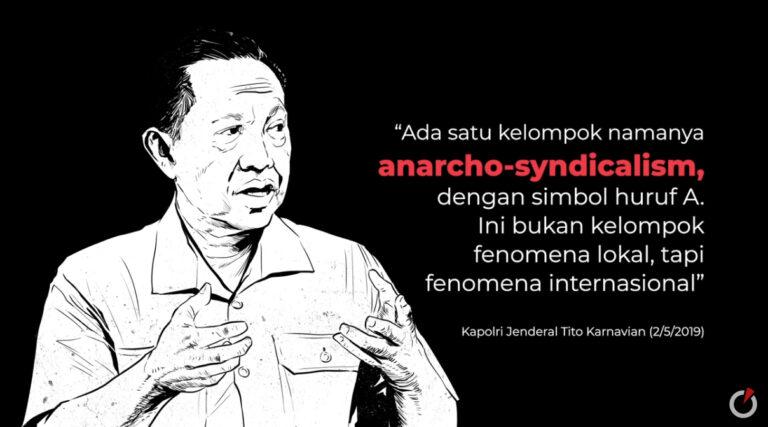
Within and beyond these evolving groups and networks, anarchists have been engaged in a wide range of activisms, including: running infoshops; publishing books, pamphlets and zines; engaging in solidarity actions with local communities; boycott and sabotage actions; demonstrations and black bloc actions; and artistic performance interventions. Important fractions of the movement are involved in community support for urban laborers, rural peasant communities, or populations suffering land grabs and ecological degradation. The proliferation of itinerant libraries (or perpustakaan jalanan), which developed from 2009 in Bandung and have spread elsewhere, highlights the focus on education. These libraries also provide free food, via public kitchens (or dapur umum) organised under the Food Not Bombs banner (Damier and Limanov 2017). The Anarkis.org website, founded in 2014, also serves as a vital resource for self-education and critical discussion within the movement.
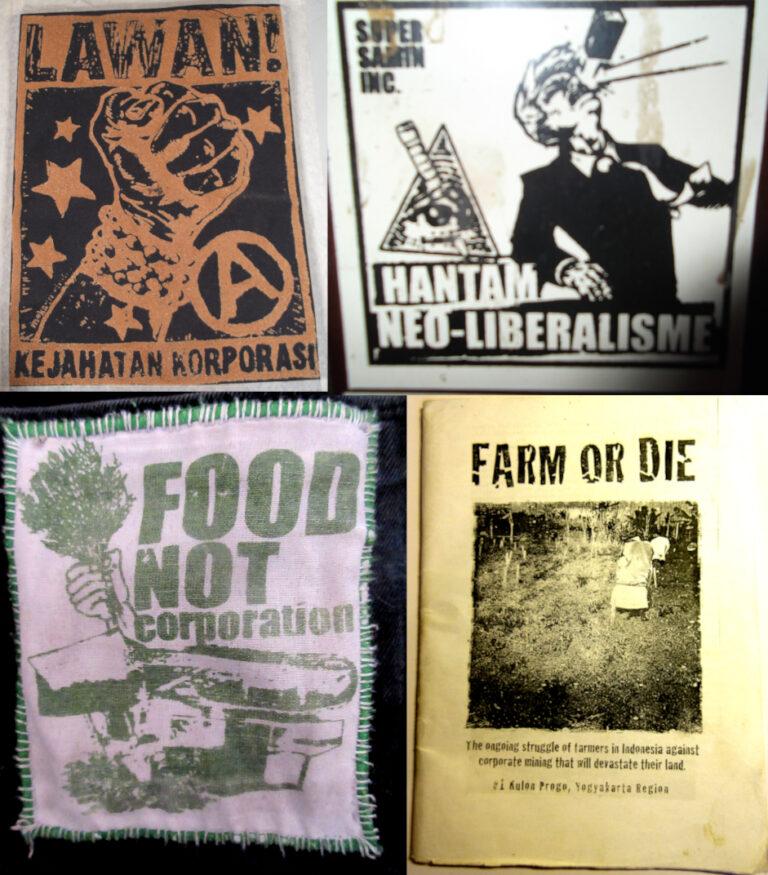
Anarchist groups in Indonesia are marked by vernacular specificities, such as the concept of family-ism, and its particular dynamic of hierarchical interpersonal relations. This structural dimension shapes the dialogue between mobilised communities and anarchist groups, who are obliged to negotiate certain power relations. The prevalence of religion and the link to spirituality are also resources of mobilisation for some anarchists. In a country where atheism is unaccepted, many movement members practice religion, and Indonesian anarchists tend to be more flexible than their European comrades – often recognising the anarchist ‘No Gods, No Masters’ ideal, while also assisting religious minority groups, like the Shia or Ahmadi people (anonymous interview 2022).
Examples of mutual aid (known locally as gotong royong), horizontal solidarity, and autonomy, are numerous among the traditional cultures of the Indonesian archipelago, although this was not labelled ‘anarchism’, of course. Indigenous communities, like the Samin people, Kajang, Dayak, Tanimbar, or Kanekes, are conceived as embedding these anarchistic practices through their collective way of life and retreat from, or resistance to, the State. In this perspective, it is not anarchism that was imported from abroad, but the State itself. These interpretations are enriched by interactions between anarchists and the inspiring traditional communities.
Anarchism under repression, and the significance of contemporary anarchist critiques
Today, after 60 years of nationalist and anti-communist propaganda, and despite the return of democracy in 1998, progressive ideas are harshly repressed as a potential resurgence of the spectre of communism. This has been the case with the large-scale popular mobilisations that have been multiplying since May 2019 in protest against the politics of money, corruption, and authoritarianism. The current red-scare label-of-choice is ‘anarcho-syndicalism’, presented as a morally deviant and conspiratorial nebula that threatens public order (Maharani 2019). In 2019, police authorities declared anarcho-syndicalists responsible for May Day riots in several major cities. During the Covid-19 pandemic, the national police announced that anarcho-syndicalists had organised attacks on public facilities across Java (Velarosdela 2020; Anjani 2020). As a result of this stigmatisation, several city authorities now even declare their rejection of the movement on publicly erected banners (Nugroho, 2016).
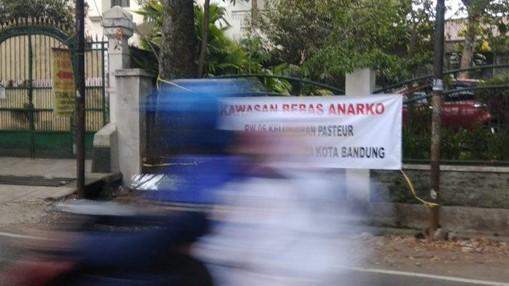
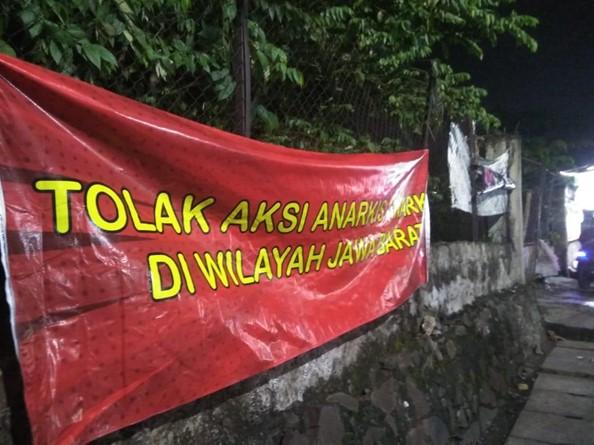
The anarchist movement appears today as the last vocal Leftist political movement in Indonesia, although it remains a weak voice in a political landscape dominated by the traditional parties linked to oligarchies, religious organisations, and business consortiums. The two terms of the current president, Joko Widodo, have further marginalised progressive ideas, increased inequality, reinforced the power of the military, and made little effort to counter environmental catastrophe. But anarchist analyses are particularly well-placed to articulate the systemic dimensions that underpin contemporary Indonesian society, and their voice is vitally important as a result.
References
-
Anjani, Kirana. Kaus Hitam dan Paranoia Negara: Stigmatisasi dan Pelanggaran Hak Kelompok Anarko-Sindikalis. Indonesia: Lokataru Foundation, 2020.
-
Blom, Ron, & Stelling, Theunis. Niet voor God en niet voor het Vaderland. Linkse soldaten, matrozen en hun organisaties tijdens de mobilisatie van ’14-’18. Amsterdam: Aspekt, 2004.
-
Damier, Vadim & Limanov, Kirill. ‘Anarchism in Indonesia’. libcom.org, 14 November 2017. https://libcom.org/article/anarchism-indonesia-0
-
Danu, Mahesa. ‘Bung Karno Dan Anarkisme’. Berdikari Online, 16 March 2015. https://www.berdikarionline.com/bung-karno-dan-anarkisme/
-
Donaghey, Jim. Punk and Anarchism: UK, Poland, Indonesia [PhD thesis]. UK: Loughborough University, 2016. https://repository.lboro.ac.uk/articles/thesis/Punk_and_anarchism_UK_Poland_Indonesia/9467177
-
Estrelita, Gloria Truly. Penyebaran Hate Crime oleh Negara Terhadap Lembaga Kebudayaan Rakyat [Master’s thesis]. Jakarta: Universitas Indonesia, 2010.
-
Final Report of the IPT 1965. https://www.tribunal1965.org/en/final-report-of-the-ipt-1965/
-
Guritno, Tatang. ‘Menyebarkan Komunisme, Marxisme, Leninisme Dapat Dipidana, Koalisi Masyarakat Sipil: Menghidupkan Orde Baru’. KOMPAS.com, 5 December 2022. https://nasional.kompas.com/read/2022/12/05/19061841/menyebarkan-komunisme-marxisme-leninisme-dapat-dipidana-koalisi-masyarakat
-
Honna, J. ‘Military Ideology in Response to Democratic Pressure during the Late Suharto Era: Political and Institutional Contexts’. Indonesia, 67, pp. 77-126, 1999.
-
Lastania, Ezther, Riky F & Jobpie S. ‘Polisi Miliki Protab Baru Anti Anarki’. tempo.co, 10 October 2010. https://metro.tempo.co/read/283651/polisi-miliki-protap-baru-anti-anarki
-
Lev, Daniel S. The Transition to Guided Democracy. UK: Equinox Publishing, 2009.
-
Mrázek, Rudolf. Sjahrir: Politics and exile in Indonesia. New York: Ithaca, 1994.
-
Nugroho, Pujo. Kota Merah Hitam. Indonesia: Solidaria.id, 2021.
-
Putra, Bima Satria. Perang yang Tidak Akan Kita Menangkan: Anarkisme dan Sindikalisme dalam Pergerakan Kolonial hingga Revolusi Indonesia (1908-1948). Indonesia: Pustaka Catut, 2018.
-
Putra, Ferdhi F. Blok Pembangkang: Gerakan Anarkis di Indonesia 1999-2011. Indonesia: EA Books, 2022.
-
Rosanti, Ratna. ‘Political Pragmatics in Indonesia Candidates, the Coalition of Political Parties and Single Candidate for Local Elections’. Jurnal Bina Praja, vol. 12, no. 2, 2020.
-
Suryomenggolo, Jafar. ‘Dari Sekolah Liar Hingga Anarkisme’. Historia, 23 May 2020. https://historia.id/politik/articles/dari-sekolah-liar-hingga-anarkisme-PG89B
-
Van Dijk, Kees. The Netherlands Indies and the Great War, 1914-1918. The Netherlands: Leiden. 2007.
-
Velarosdela, R. N. ‘Polisi Selidik Dalang Kelompok Anarko yang Berencana Lakukan Vandalisme Massal’. Kompas, 13 April 2020. https://megapolitan. kompas.com/read/2020/04/13/18103381/polisi- selidik-dalang-kelompok-anarko-yang-berencana- lakukan-vandalisme
-
Wardaya, Baskara T. Indonesia Melawan Amerika Konflik PD 1953-1963. Yogyakarta: Galangpress, 2008.
